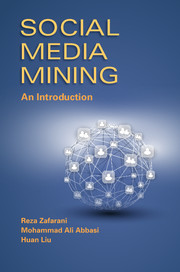6 - Community Analysis
from Part II - Communities and Interactions
Published online by Cambridge University Press: 05 July 2014
Summary
In November 2010, a team of Dutch law enforcement agents dismantled a community of 30 million infected computers across the globe that were sending more than 3.6 billion daily spam mails. These distributed networks of infected computers are called botnets. The community of computers in a botnet transmit spam or viruses across the web without their owner's permission. The members of a botnet are rarely known; however, it is vital to identify these botnet communities and analyze their behavior to enhance internet security. This is an example of community analysis. In this chapter, we discuss community analysis in social media.
Also known as groups, clusters, or cohesive subgroups, communities have been studied extensively in many fields and, in particular, the social sciences. In social media mining, analyzing communities is essential. Studying communities in social media is important for many reasons. First, individuals often form groups based on their interests, and when studying individuals, we are interested in identifying these groups. Consider the importance of finding groups with similar reading tastes by an online book seller for recommendation purposes. Second, groups provide a clear global view of user interactions, whereas a local-view of individual behavior is often noisy and ad hoc. Finally, some behaviors are only observable in a group setting and not on an individual level. This is because the individual's behavior can fluctuate, but group collective behavior is more robust to change. Consider the interactions between two opposing political groups on social media. Two individuals, one from each group, can hold similar opinions on a subject, but what is important is that their communities can exhibit opposing views on the same subject.
- Type
- Chapter
- Information
- Social Media MiningAn Introduction, pp. 141 - 178Publisher: Cambridge University PressPrint publication year: 2014



